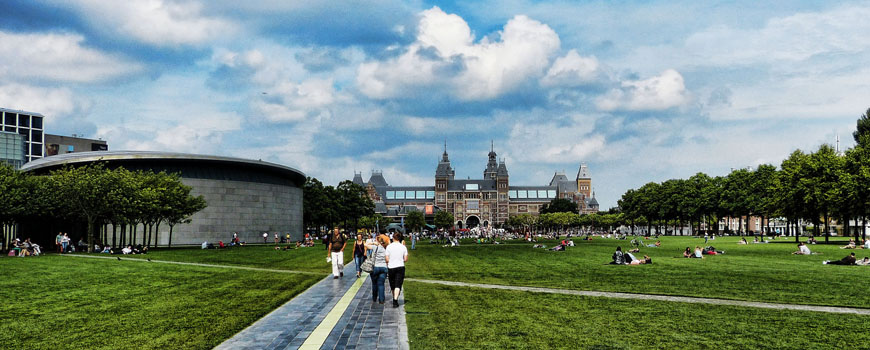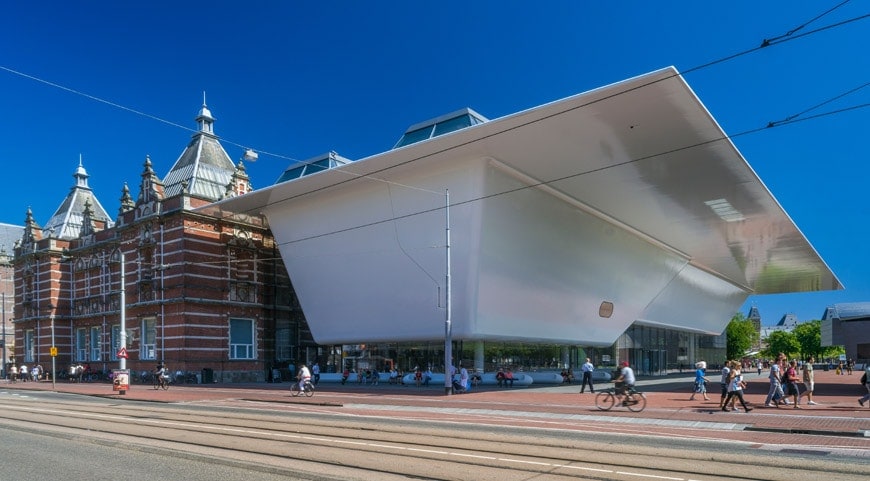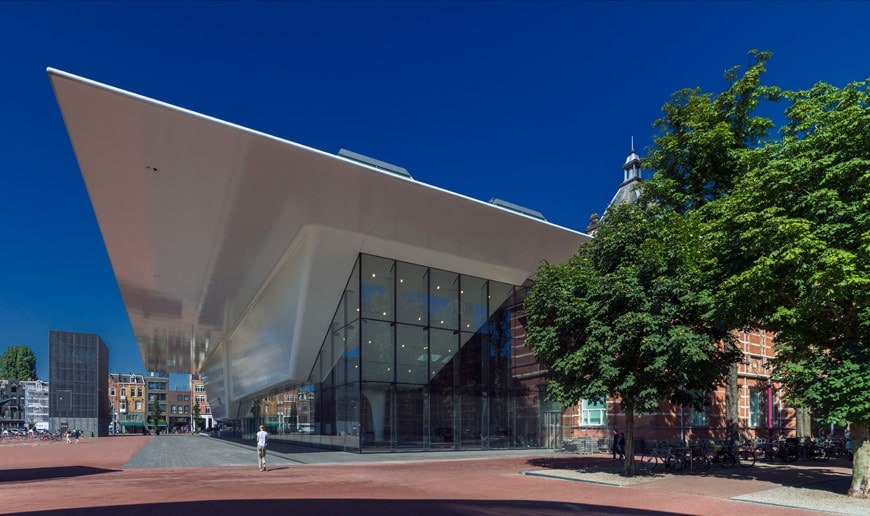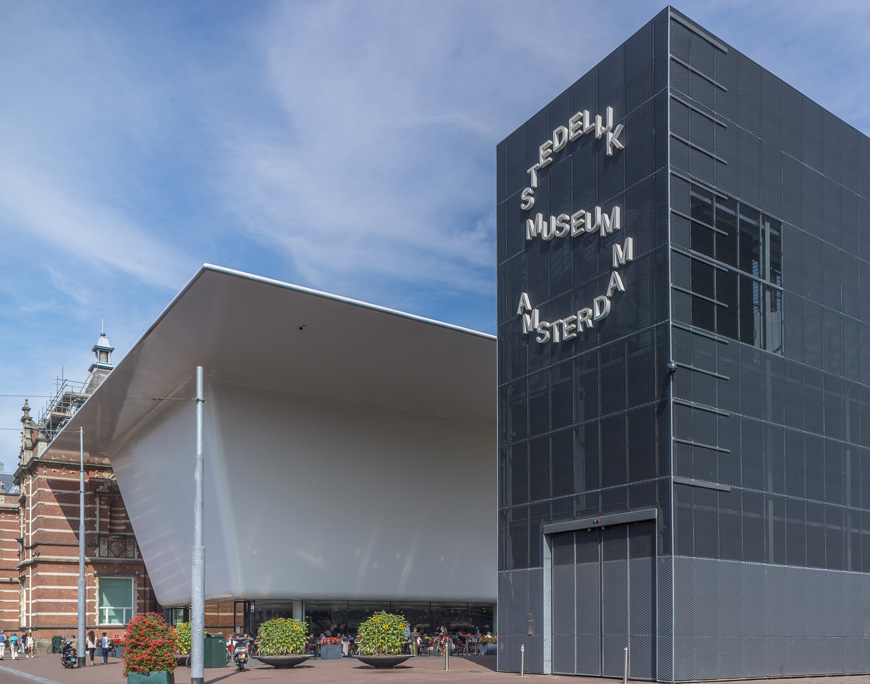Benthem Crouwel Architekten, Stedelijk Museum’s expansion and renovation
Client: City of Amsterdam
Benthem Crouwel Architekten
Engineers: Arup
Technical Engineers: Imtech
Stedelijk Museum Amsterdam, the original building (A.W. Weissman, 1895), and the new building (designed by Benthem Crouwel Architects). Photo: John Lewis Marshall, courtesy of Stedelijk Museum.
The Stedelijk museum extension | Benthem Crouwel Architekten
The Stedelijk has a long history of being “the museum” in Amsterdam for modern and contemporary art. Founded in 1895, since its opening the Stedelijk has been housed in a Renaissance Revival building, designed by Adriaan Willem Weissman. In 1938 Willem Sandberg, the director of the museum, decided to remove all the interior decorations and paint all rooms white creating one of the first “white-boxes” exhibition galleries in a historical building. After almost a century of uninterrupted activity, at the beginning of the 1990s, the old building proved outdated for the requirements and functions of a modern museum, lacking the necessary fire safety and artwork conservation performances.
After a quite troubled process, in 2004 a design by Benthem Crouwel Architekten was eventually selected for the renovation and extension of the museum which was completed in 2012.
The new 9,400-square-meter extension is certainly the most important element of the winning design. It provides the museum with a new entrance lobby, up-to-date visitor services, and additional exhibition rooms. But even more important, the new building creates an improved relationship between the museum and the surrounding urban space. Indeed, the Stedelijk, together with the Rijksmuseum, the Van Gogh Museum, and the Concertgebouw concert hall, overlooks the Museumplein Park, creating one of Europe’s most interesting cultural sites.
Stedelijk Museum Amsterdam, facade as seen from the Van Gogh Museum. Photo: John Lewis Marshall, courtesy of Stedelijk Museum
A white contemporary construction, completely transparent at its entrance level: the appearance of the new wing is conceived to be distinct from the adjoining brick palace. Nevertheless, its dimensions, and particularly its height, are carefully tuned to Weissman’s older building. Despite its simple, rectangular footprint, the addition has a quite peculiar form, which earned the building its nickname, “The bathtub”, that progressively expands vertically, ending with a large overhanging flat roof intended to provide a sheltered and gathering outdoor space projected into the park. Benthem Crouwel also wanted the addition to be a lightweight construction with a load-bearing structure mainly made of steel and highly innovative external cladding consisting of 271 panels made with a composite material based on Twaron®, a para-aramid fiber produced by the Dutch-Japanese company Teijin and usually adopted in boat construction. The use of a composite material allowed a seamless, lightweight, fire-proof, and durable building skin.
Stedelijk Museum Amsterdam and Richard Serra’s Sight Point. Photo: John Lewis Marshall, courtesy of Stedelijk Museum
Stedelijk Museum Amsterdam, as seen from the Van Baerlestraat. Photo: John Lewis Marshall, courtesy of Stedelijk Museum
The Stedelijk Museum Amsterdam from the Museumplein (Museum Plaza).
Photo: Ernst van Deursen, courtesy of Stedelijk Museum
The building has three floors, two over and one below the ground. The entrance level contains the entrance lobby, a library, and a restaurant; the underground floor houses the largest free-span exhibition space in the Netherlands and a small theatre and performance space; other exhibition galleries are located on the first floor together with the connections with the old building. From the underground level, visitors can go directly to the first floor through a “yellow tube” enclosing two escalators, so that all exhibition spaces on different levels are nevertheless interconnected without interruptions and distractions.
The exhibition galleries are quite neutral, white-colored, and inspired by the exhibition principles introduced by Sandberg in the thirties. The spaces on the upper floor are also filled with natural light through a series of ceiling windows. From the inside, the distinction between the old and the new buildings, so evident externally, almost disappears and is hardly noticeable. Along with the construction of the extension, the 19th-century building underwent a complete renovation, thus establishing the Stedelijk, with an overall surface of 26,000 square meters, as one of the most up-to-date modern and contemporary art centers in Europe.
Installation view from the exhibition ‘Tomorrow is a Different Day – 1980 – Now.
Photo: Gert-Jan van Rooij

Founded in 1874 in Amsterdam, the Stedelijk is a museum of Dutch, European, and American modern and contemporary fine art, graphic arts, and design

Amsterdam
copyright Inexhibit 2024 - ISSN: 2283-5474







